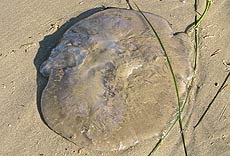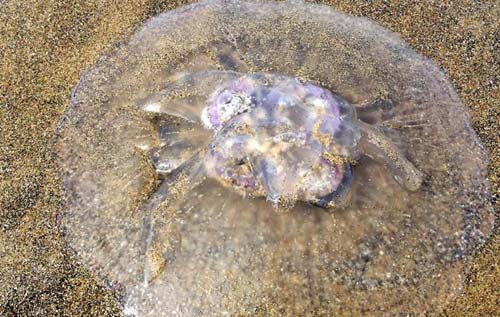All About the Moon Jelly on Oregon Coast: Surreal, Translucent
Published 11/18/2018 at 4:59 AM PDT
By Oregon Coast Beach Connection Staff

(Oregon Coast) – There have been small reports of them around the Oregon coast, but it was Tiffany Boothe of Seaside Aquarium that really documented the find. An interesting species of jellyfish has been stranding along the coastline lately. And it's not that unusual. (All photos courtesy Boothe / Seaside Aquarium).
Includes exclusive listings; some specials in winter
In Cannon Beach:
Includes rentals not listed anywhere else
In Manzanita, Wheeler, Rockaway Beach:
Some specials for winter
In Pacific City, Oceanside:
Some specials for winter
In Lincoln City:
Some specials for winter
In Depoe Bay, Gleneden Beach:
Some specials for winter
In Newport:
Look for some specials
In Waldport
Some specials for winter
In Yachats, Florence
Some specials for winter
As Tiffany put it last week: “Look what the tide has brought in...moon jellies!”
They are known by the name Aurelia aurita, and they are boneless and brainless.
“This species of jellyfish ranges from Alaska to California, and is the proverbial ‘drifter,’ as it floats along wherever the ocean’s current takes it,” Boothe said. “They eat tiny marine life such as plankton and diatoms, which they pick up with the tiny hair-like tentacles that lace the outside edge of the jellyfish. Though they sting their prey, us large, thick-skinned humans cannot be harmed by this jelly.”
Like all invertebrates, they have no heart either. In the water, they are spread out in full form, with a bell on the top of the magnificent and surreal creature. Boothe said this species is unique among jellies because although they have those stinging cells, they can’t even be felt by humans.
Although quite common off the Oregon coast, moon jellies are more common in tropical waters. Yet they have a very wide range of temperature tolerances, from as low as 21 degrees up to nearly 90 degrees.
When moon jellies show up along the Oregon coast, they’re often around a foot in diameter. They can be smaller or larger. You may find dozens at a time or just a few here and there. However, they don’t show up in enormous numbers like those purple sailors (or velella velella as they’re mostly known). Those tinier creatures – vaguely related to a jellyfish – can show up in thousands at a time, causing a nasty stink if they’re left to dry in the sun.
 Why do they show up? The ocean off the Oregon coast is simply a very dynamic place and things wash up all the time. Often with jellyfish it’s because the wind pushes them. According to the Seaside Aquarium, there was probably many of them out there when the winds took charge of their destiny.
Why do they show up? The ocean off the Oregon coast is simply a very dynamic place and things wash up all the time. Often with jellyfish it’s because the wind pushes them. According to the Seaside Aquarium, there was probably many of them out there when the winds took charge of their destiny.
The Aurelia aurita is one of about ten jellyfish that are very similar, and it’s often hard to tell them apart from each other.
Moon jellies are translucent, and with their limited movement capabilities only drift with the currents. They feed by stinging small plankton and mollusks with prickly little tentacles, then moving the their food into their body for digestion. They also feed on crustaceans, tunicate larvae, protozoans, diatoms, fish eggs and other similarly small organisms.
How they breathe is also a curiosity. Moon jellies do not have breathing organs such as gills or lungs, but instead diffuse oxygen from water through a thin membrane.
It’s not uncommon for either the Seaside Aquarium or the Oregon Coast Aquarium to have them on display. Oregon Coast Lodgings in this area - Where to eat - Maps - Virtual Tours
Cannon Beach Lodging
Nehalem Bay Lodgings
Manzanita Hotels, Lodging
Three Capes Lodging
Pacific City Hotels, Lodging
Lincoln City Lodging
Depoe Bay Lodging
Newport Lodging
Waldport Lodging
Yachats Lodging
Oregon Coast Vacation Rentals
Oregon Coast Lodging Specials

Photo above taken by Haystack Rock Awareness Program. Below, more photos from Boothe and Seaside Aquarium.



More About Oregon Coast hotels, lodging.....
More About Oregon Coast Restaurants, Dining.....
LATEST Related Oregon Coast Articles
Likely just before dawn best hour but peak happens during daylight. Weather
Dark Sky Week is Prime Along Oregon Coast: Where and Where Not to Go
General guide to dark sky viewing from south to north coast. Astronomy
Sizable Price Drop, Deals in Lincoln City During Quiet of April on Central Or...
20 perc off at A1 Vacation Rentals across its roster, including Gleneden Beach. Lincoln City specials
Upcoming S. Oregon Coast Events Include Gem Show, History: Coos Bay, Bandon
May 6 talk at Coos History Museum, Mayfly Fest May 17, Bandon Rock / Gem Show June 7,8
Washington Coast Cleanup on April 19 - Coinciding with Oregon Coast's SOLVE E...
From the Puget Sound to Long Beach, alongside Oregon's cleanup. Washington coast events, Seaside events
Astoria's Riverwalk Gets New Lighting, More N. Oregon Coast Roadwork
Delays coming this summer, but the riverwalk has a new look. Seaside, Cannn Beach
April Gets Even Cheaper Midweek at Depoe Bay, Lincoln City: Oregon Coast Deals
Off-season rates plus more at Keystone Vacation Rentals. Depoe Bay lodging specials, Lincoln City hotel reviews, Newport hotel reviews
Washington Coast Begins Week of Clam Digs, April 12 Through 18
Long Beach, Twin Harbors, Mocrocks and Copalis at different times. Washington coast events
Back to Oregon Coast
Contact Advertise on BeachConnection.net
All Content, unless otherwise attributed, copyright BeachConnection.net Unauthorized use or publication is not permitted














































